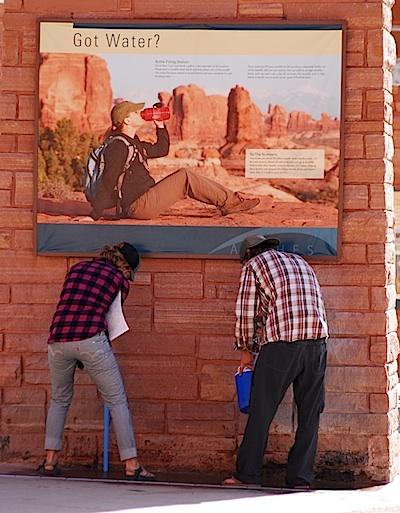
More and more parks are installing water-filling stations, such as this one at Arches National Park/Kurt Repanshek
Nearly two dozen units of the National Park System have instituted bans against the sale of disposable water bottles, a move proponents say will greatly reduce trash.
For most parks, according to Public Employees for Environmental Responsibility, disposable plastic water bottles represent the biggest source of trash that parks must pay to haul away, averaging nearly one-third of all solid waste in parks surveyed.
"Ending sales of plastic bottles in national parks has gotten off to a slow start due to the influence of Coca-Cola, whose Dasani bottled water is one of the top sellers, on top National Park Service officials," PEER maintains. "In 2010, just days before a long-planned plastic bottle ban at Grand Canyon National Park was to take effect, NPS Director Jon Jarvis blocked it at the company's behest. Even more significantly, NPS abandoned its plan to end disposable water product sales in 75 percent of all visitor facilities by 2016."
However, after the matter gained public attention the Park Service director relented, though he issued a directive that required parks to extensively study the impacts of instituting such a ban before they would be permitted to do so.
The analysis required elaborate assessments that included a review of the amount of waste that could be eliminated from the park; the costs of installing and maintaining water filling stations for visitors; the resulting impact on concessionaire and cooperative association revenues, and consultation with the Park Service's Public Health Office.
The analysis also dictated the consideration of "contractual implications" to concessionaires, the cost and availability of BPA-free reusable containers, and signage so visitors could find water filling stations.
Perhaps due to the controversy, only a handful of national parks adopted bans under the new policy in 2012, its first full year. In 2013, records obtained by PEER indicate that no park that sought a bottle sale ban was turned down and another six parks went bottle-free:
* Colorado National Monument;
* In Texas, Pecos and San Antonio Missions national historic parks;
* In North Carolina, the Outer Banks Group; and
* In Utah, Natural Bridges and Hovenweep national monuments.
Beyond the 23 parks in 10 states that already do not sell plastic water bottles, California's Golden Gate National Recreational Area, the most heavily visited national park, and Florida's Biscayne Bay National Park, are both installing water 'filling stations' to provide free water to visitors. In addition, Washington's Mount Rainier National Park indicates it is working on a ban, according to PEER.
"From desert to ocean parks, from remote wilderness to urban enclaves, the drive to remove the blanket of discarded plastic bottles appears to be slowly regaining momentum," said PEER Executive Director Jeff Ruch, noting that NPS replaced its goal of a ban on bottle sales at 75 percent of facilities with a vaguer target that parks cut solid waste streams by half by 2016, the year of the NPS Centennial.
"National Parks will be hard pressed to meet the goal of cutting their expensive and un-ecological solid waste load by half without addressing plastic bottles -- the single largest source of trash in most parks," said Mr. Ruch.
Word that nearly two dozen parks had banned the sale of the plastic bottle was praised by Corporate Accountability International, which long has lobbied for the ban.
"We applaud the more than 20 national parks that have ended the sale of bottled water on park lands, taking a critical step towards reducing waste and standing up as leaders within the park service by protecting water as a public good," said Erin Diaz, director of the Think Outside the Bottle campaign at the organization.
'With the support of our members, allies, and hundreds of small businesses, organizations and park partners, Corporate Accountability International is calling on the the National Park Service to end the sale of bottled water."



Comments
How so?
ec--A person as smart as you appear to be surely must recognize the difference between "man's accomplishment and progress" and just simple convenience. If you don't, then the first part of the above sentence is not true.
Rick
I quess I am just not as smart as you Rick. I am sure the inventer of PET and the millions of people that use his product will be disappointed you don't see it as an accomplishment.
I guess we should be thankful that we have Lee to tell us what we "need" and you to define what is or is not progress or an accomplishment.
Not really a helluva lot different from you letting us know what is important or immaterial now, is it? Get off your high horse, and really do consider upping your dietary fiber.
Rick B. Why am I not surprised that you would be defending someone that wants to tell other people what they need.
Not really a helluva lot different from you letting us know what is important or immaterial now, is it?
If I didn't know better, I'd have to say this thread is dead and gone, sapped dry, as it were. So we're shutting 'er down!